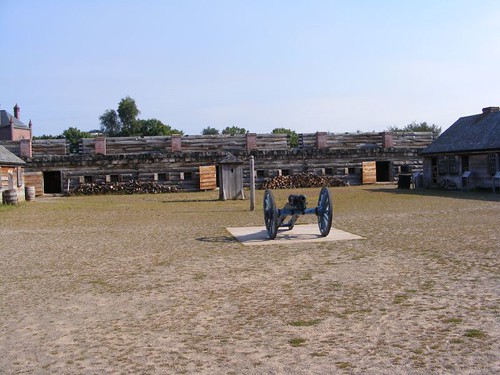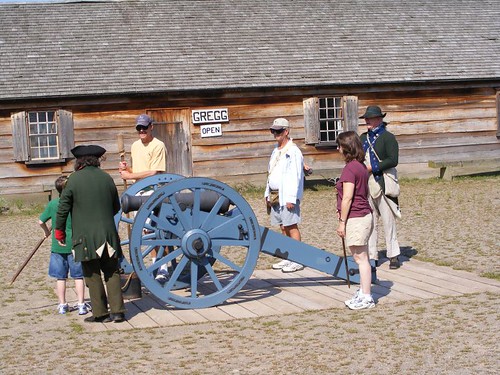September 7, 2009
On Sept. 4, we left the dock at Herkimer after the fog lifted. It appeared we were going to be traveling in a part of the canal that was more ditch-like than river-like, with the NY Thruway noise close by, two negatives on my list. Plus, there was a lot of floating debris, sticks, logs, branches, another negative on my list. It was the first time we had seen much debris on the Erie Canal, and it was unusual since we hadn't had any rainy weather to wash stuff from the inflowing streams.
A work dredge, who was notified by one of the lock attendants that we were headed in his direction, contacted us to tell us that we needed to hold back until he could move out of the way. As we got close, he called us and said we were much bigger than he realized and that since he could only move so far, we would have to slowly inch our way as close as we could get to him to get by his work area. He put a man out on his side closest to us to direct us over as near as we could get; Eddie was outside and could have shaken hands with the guy on the barge. At least they were all friendly, and they even asked questions about FLUKE as we were inching by.
Lock 20 was noteworthy for two reasons. The walls are in quite a state of disrepair, and pieces (like cement and small rocks) of the sides crumbled off when we touched them to fend off and fell down on the boat. Lock 20 is the last lock that will take us farther up; we are now at 420'. As we continue westward we will go through locks that will be lowering us.
The city of Rome, where we ended up, is located in what was a position of important geological prominence since humans have been tromping through this area. It is at the juncture of where the Mohawk River began its easterly flow all the way to the Hudson River (and then the Atlantic Ocean) and Wood Creek began its westerly flow to Lake Ontario.
The old canal terminal wall where we are docked is part of the area known as the Oneida Carrying Place. The name comes from the Oneida Indians who inhabited this prime trading area and the fact that travelers portaged their vessels six miles from one river to the other right by here. It represented an important link to connect Lake Ontario to the Atlantic Ocean.
The British recognized the importance of the area and built Fort Stanwix in 1758 to help them fight the French and Indian War. After the British won the war, the fort was abandoned in 1763. In 1776 Gen. Geo. Washington was ordered to rebuild the fort to serve as a foothold for future westward expansion. In August of 1777, British troops and their Indian allies laid siege to the fort for almost the whole month. The British troops outnumbered the Continental soldiers 2 to 1, but were unable to penetrate the well-built fort. The siege was ended when Maj. Gen. Benedict Arnold arrived to reinforce the fort's garrison.
After the war ended, peace was made with the local Indians, and the Oneida Carrying Place opened up again. Fort Stanwix was no longer needed to defend the area and was let go into disrepair. Eventually the land upon which it sat was built upon as part of the city of Rome's burgeoning growth. In July 1817 the construction of the original Erie Canal began not far from where Fort Stanwix once stood.
In 1976 the city of Rome partnered with the National Park Service to rebuild a replica of Fort Stanwix using many of the original plans and documents. First, they had to purchase all the properties existing where the fort once stood, encompassing several modern day city blocks, 16 acres in all. Somehow they managed to sell the local citizens on the benefits the project had to offer and successfully launched the project. After razing the site, archeological digs were conducted to collect artifacts from what was the original Fort Stanwix foundation. Then the "new" fort was built almost as a faithful replica of the original, probably being the largest wooden fort in American today. The fort isn't just represented by the wooden buildings and four bastions themselves; it also includes the acres of ditches, berms, and surrounding bare areas (glacis) that were instrumental to protecting the structure itself. Photos at the fort show the before and after shots, and really give you a feeling of how unique the new Fort Stanwix is, an oasis sitting right in amongst the modern city buildings and streets.
The inside of the fort gives you a feel for what life must have been like for the 800 soldiers housed within its walls: OK for a visit, but not the kind of place you'd like to spend even one night at. You can see officers' quarters, the sally port, barracks, dining areas, powder room, and various bastions. All the areas have some interiors set up depicting what the insides would have been like.
The morning we were there, was one of the days they had artillery demonstrations. There are volunteers, dressed in period costumes, who answer questions, give tours, and lead in demonstrations. The "artillery commander" said he needed 6 volunteers to fire one of the cannons; Eddie and Wayne volunteered. Wayne's job was to swab out the cannon to make sure no residue was left from previous firings that would interfere with a new firing and ramming in the charge and ball. Eddie's job was to hold his finger over the vent hole so the cannon didn't lose prime and also to fill the hole with the gun powder that would blow the cannonball out of the cannon. Having just toured the Remington Arms factory, they were psyched!
The artillery commander took each of the six recruits through their job specs. Then he wanted them to work as a team and go through the jobs without his assistance to see if they could get the cannon to fire correctly. So, they started to try to do it, but then I began asking questions. The artillery commander would answer my questions and not pay attention to his recruits. Wayne and Eddie yelled over at me to shut up while they were trying to do their "jobs". Hey, the commander didn't say no one could ask questions, and I had some good ones: what did they do about the recoil from the cannon and didn't the cannon get hot enough to burn the finger of the man plugging the vent hole? Plus, I really think the commander liked answering my questions.
Wayne and Eddie received honorable discharges from the Continental Army, and we could get on with our boating lives. We have spent a lot of time walking around the areas near the waterfront. We are close to what was originally settled as the Little Italy section of Rome; even today most of the storefronts in the area have Italian names. Modern shops are conveniently located within a reasonable walking distance; by our definition that is 2 miles or less. We walked over to the Friday night Cruise In, where locals bring their restored and souped up cars for people to ogle over and ask questions about. They even had a local DJ from the "Oldies" station doing a live radio show and giving out door prizes. Eddie went back in time to the 50s when he did the same thing to his cars. I was thankful he didn't have any cigarettes to roll up in his sleeve, and he doesn't have enough hair left to wear it in a pompadour.
Since it has been the Labor Day holiday weekend we have just stayed put. We were concerned we may not find as suitable a place with people being off for the long weekend. FLUKE is the biggest boat we have seen since we have been this far west, and docks for her size are limited. However, tomorrow we continue onward.
Monday, September 07, 2009
Subscribe to:
Post Comments (Atom)










0 comments:
Post a Comment